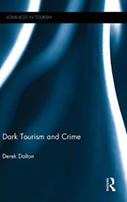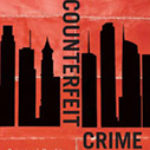Dark Tourism And Crime

Author: Derek Dalton
Publisher: London: Routledge, 2015. 216p.
Reviewer: Kevin Walby | March 2017
Dark tourism involves visits to and tours of sites of death, atrocity, violence, and disaster. These places are gaining in popularity across the globe. Dark Tourism and Crime explores some of the most prominent disreputable destinations out there. As Derek Dalton argues, such dark tourism sites are milieus of past crimes, and therefore should be of great interest to criminology and criminal justice scholars. Dalton is not for or against dark tourism locales, but instead is interested in exploring how they convey meaning about crime and punishment in contemporary society. As he puts it, “[s]ome crimes…are so historically, culturally and socially important that they warrant deliberate commemoration and memorialisation…” (pg. 1). Turning such dark spots into tourist destinations allows sites of past crimes to become repurposed for education and entertainment.
Before delving into empirical matters, Dalton addresses a few prominent conceptual and methodological issues. In terms of conceptual terrain, he covers literature on dark tourism and some alternative concepts such as trauma tourism and death tourism. Dalton also assesses debates about dark tourism supply and demand. Methodologically, the author explains how and why he conducted observations and took photographs at the sites he visited. Dalton also confesses to tensions he experienced during his research, such as feeling like a tourist as well as having prior (sometimes stereotypical) knowledge of the sites.
The first chapter explores representations of suffering and death at the Auschwitz death camp in Poland. Dalton is careful to note that one favourite tourist attraction (the “death wall”) is an “inauthentic installation” (pg. 22). This observation sets the tone for Dark Tourism and Crime, which reveals the ways that tourist encounters with authenticity are staged at even the saddest, most sombre ‘dark’ destinations. Dalton also contrasts the highly-controlled form of tourism at Auschwitz with his experience at another Nazi death camp, Birkenau. The researcher was able to navigate the latter in a less channelled, more exploratory manner.
The second chapter then examines dark tourism in Oradour-sur-Glane, the site of a mass Nazi execution of 642 French citizens. The ruins of the ancient town now stand as a reminder of Nazi atrocities. The author uses photography to “appreciate the horrors of the crimes that took place…” (pg. 48). Part of Dalton’s approach is looking for “signs of crimes” in these sites.
The third chapter considers tourism related to genocide, and the particular instance of the killing fields in Cambodia. First, Dalton examines the Tuol Sleng Genocide Museum, which is located in the former S-21 detention centre. He focuses specifically on the torture cells and the brick isolation cells. Next, he visits the Choeung Ek Genocidal Centre, reflecting on the displays of human remains and mass graves. He then comments on what he calls “unremarked dark tourism” (pg. 77) in Cambodia, referring to sites and forms of atrocity that have yet to be memorialised, and that remain obfuscated or erased. The author also offers reflections on Cambodia’s plans to create luxury tourism resorts and destinations to lure more foreign visitors and money.
In the fourth chapter, Dalton investigates dark tourism related to Argentina’s dirty war, which lead to the execution and exile of thousands. First, the author explores the disreputable ESMA detention centre. Focusing on how encounters with authenticity are staged or manipulated, Dalton argues “the characteristics of the building were deliberately altered and modified after the Dirty War ended” (pg. 85). He contrasts reports of torture with the now “paradoxically empty” (pg. 104) rooms and halls to raise questions about the politics of representation in dark tourism sites. He then visits the Parque de la Memoria, an outdoor space filled with monuments and “memory signs” (98) to the 30,000 disappeared persons presumed missing and murdered. The author also observes the actions of the Mothers of the Plaza de Mayo who habitually remember their missing sons and daughters in mass public memorials and emotional pleas for justice. Chapter 5 examines dark tourism in Chile, specifically at the Villa Grimaldi Peace Park, 38 London Street, and the Victor Jara Stadium. Dalton argues that the crimes of the Pinochet regime are less apparent and even hidden at the latter two sites. The author also comments on the politics of repurposing Victor Jara Stadium as a homeless shelter.
The final two empirical chapters consider dark tourism in Tasmania, and in New York City. Given its history of violence and the notable mass shooting that occurred there in 1996, the author conceptualizes Port Arthur, Tasmania, as a “traumascape”. He reflects on the longstanding overlap among tourism, crime, and punishment in Port Arthur, and contemplates that city’s future. Turning his attention to New York, Dalton investigates the site of the shooting of John Lennon, and the space of the September 11, 2001 attacks. He compares the techniques of memorialization and the creation of marketable souvenirs for both sites.
The conclusion raises a number of important analytical and political points. First, the author argues that dark tourism sites are important to visit, and are imperative to build. These spaces, museums, and monuments are sometimes the only way to remember and to educate people regarding past crimes and atrocities. However, Dalton cautions that memorialization must be done professionally and ethically, or it can become a farce and further inflict violence and suffering upon victims and their families. Second, the author suggests that the crimes of colonization and colonial regimes in Australia (and I would include Canada and the United States as well) are currently obfuscated and erased. He argues that policymakers, heritage professionals, and scholars have a responsibility to uncover these sites and curate them wisely (pg. 180). The author mentions the rise of online dark tourism experiences. The reader is left with a methodological question: how should we conduct dark tourism research at sites where all buildings, evidence, objects, and traces of the atrocity are completely erased? Where there is no “sign of crime” (pg. 190) as Dalton puts it, how can researchers begin to conduct research? These certainly are important, provocative ideas for future research.
While Dark Tourism and Crime is full of conceptual and empirical strengths, I did have some reservations about a couple of core terms that the author uses. The dark tourism notion has been thoroughly critiqued, and although Dalton acknowledges these critiques, he nevertheless uses this notion without caveats. The critiques of the term notably include the idea that the notion of ‘dark’ is analytically insufficient and cannot be salvaged. Perhaps of greater interest to criminology and criminal justice scholars, Dalton also applies the “crime” label quite widely and broadly. This goes against the work of many critical criminologists, who for a variety of reasons advocate jettisoning the crime notion in favour of terms such as harm (e.g., Hulsman 1986). Added to this, I would simply note that at many of these sites, charges and prosecutions did not follow for many of the participants who had perpetrated the violence — which raises questions about whether the atrocities are accurately called a crime, if they have not been arraigned as such. Finally, to respond to one of Dalton’s concluding queries, I would suggest that what is being called counter-visual analysis can be used when all buildings, evidence, objects, and traces of the atrocity are destroyed in such sites (e.g., Walby 2017). Though I do not have the space here to elaborate, counter-visual analysis provides a methodological approach that can be applied in former sites of atrocity, when the indicators have been obfuscated.
I do not mean to suggest that Dark Tourism and Crime is somehow flawed. All books have minor problems, and Dark Tourism and Crime has very few compared to some others. The research and writing bring the reader directly to the sites. It is an enjoyable, illuminating read. The analysis is sweeping and impressive in scope. The depth and quality of the research is compelling. I do not hesitate in stating that qualitative criminology and criminal justice scholars around the world, who study culture, museums, tourism, and representations of crime will learn a lot from reading this book.
References
Hulsman, L. 1986. ‘Critical Criminology and the Concept of Crime’. Contemporary Crises 10(1): 63-80.
Walby, K. 2017. ‘Cyclonic Capitalist Development in Uranium City, Saskatchewan: a Counter-Visual Analysis’. Annual Review of Interdisciplinary Justice Research 6: 199-229.
Kevin Walby, Chancellor’s Research Chair and Associate Professor, Criminal Justice, University of Winnipeg.


